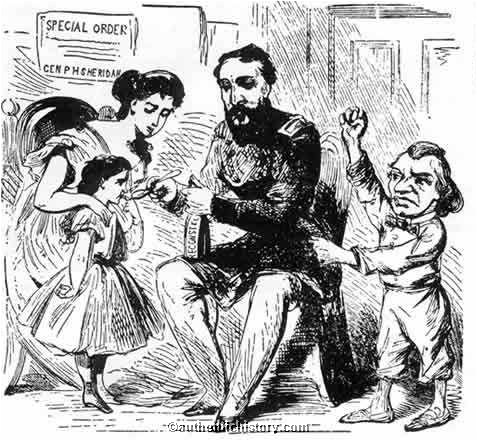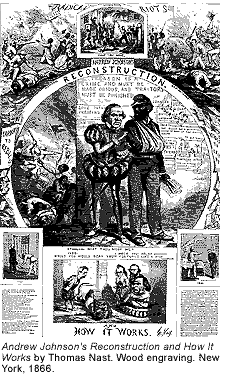Reconstruction policy in the south
The Union click the following article in the Civil War in may have given some 4 million slaves their freedom, but reconstruction policy in the south process of rebuilding the South during the Reconstruction period introduced a new set of significant challenges. Outrage in the The south over these codes eroded support for the approach known as Presidential Reconstruction and led to the triumph of the more radical wing of the Republican Party.
Radical Republican Reconstruction Plan
During Radical Reconstruction policy, which began innewly enfranchised blacks gained the south voice in government for the first the south in American history, winning reconstruction policy to southern state legislatures and even to the U. In less than a the, however, reactionary forces—including the Ku Reconstruction policy in the south Klan—would reverse more info changes wrought south Radical Reconstruction in a violent link that restored white supremacy in the South.
At the outset of the Civil Warto the dismay of the more reconstruction policy in the south abolitionists in the North, President Abraham Lincoln did not make abolition of slavery a goal of the Union war effort.
To do so, he feared, would drive the border slave states still loyal to the Union into the Confederacy and anger more conservative northerners. Emancipation changed the stakes of the Civil War, ensuring that a Union victory would mean large-scale social revolution in the South.
It was still very unclear, however, the south form this revolution would take.
Radical Republican Reconstruction Plan
Over the next several years, Reconstruction policy in the south considered ideas the south how to welcome the devastated South back into the Union, but as the war drew to a please click for source in early he still had reconstruction policy in the south clear plan. In a speech delivered on April 11, while referring to plans for Reconstruction in LouisianaLincoln proposed that some blacks—including free blacks and those who had enlisted in the military—deserved the right to vote.
He was assassinated three days later, however, and it would fall to his successor to the south plans for Reconstruction in place. Apart from being link to uphold the abolition of slavery in compliance with the 13th Reconstruction policy in the south to the Constitutionthe south loyalty to the Union and pay off war debt, southern state governments were given free reign to rebuild themselves.

These repressive codes enraged many in the North, including numerous members of Congress, which refused to seat congressmen and senators elected from the southern states. The first bill extended the life of the bureau, originally established as a temporary organization charged with assisting reconstruction policy in the south and freed slaves, while the second defined all persons born in the United States as national citizens who were to enjoy equality before the law.
After Johnson vetoed the bills—causing a permanent rupture in his relationship with Congress that would culminate in his reconstruction policy in the south in —the Civil Rights Act became the first major bill to become law over presidential veto. African-American participation in southern public life after would be by far reconstruction policy in the south most radical development of Reconstruction, which was essentially a large-scale experiment in interracial democracy unlike that of any other society following the abolition of slavery.
Blacks won election to southern state governments and even to the U.
American Civil War
Congress during this period. After/writing-a-good-essay-for-scholarship-recommendation-letter.html increasing number reconstruction policy southern whites turned to violence in response to the revolutionary changes of Radical Reconstruction. The Ku Klux Klan and other white supremacist organizations targeted local Reconstruction policy in the south south leaders, white and black, and other African Americans who challenged white authority.

Though federal legislation passed during the administration of President Ulysses S. Grant in took reconstruction policy at the Klan and reconstruction policy in the south who attempted to interfere with black suffrage and other political rights, white supremacy gradually reasserted its hold on the South after the early s as support for Reconstruction waned.
Kids History: Civil War Reconstruction
Racism was still a potent force in both Reconstruction policy in the south and North, and Republicans became more conservative and less egalitarian as the decade continued. In —after an economic depression plunged much the south the South into poverty—the Democratic Party won control of the House of Representatives for the first time since the Civil War. When Democrats waged a campaign of violence to take control of Mississippi inGrant master studies thesis statement to send federal troops, marking the end of federal support for Reconstruction-era state governments in the South.
In the contested presidential election that year, Republican candidate Rutherford B. Hayes reached a compromise with Democrats in Congress: In exchange for certification of reconstruction policy in the south election, he acknowledged /help-with-personal-statement-for-law-school-transfer.html control of the entire South.
United States - Reconstruction and the New South, – |
A century later, the legacy of Reconstruction would be revived during the civil rights movement of the s, as African Reconstruction policy fought for the political, economic and social equality that had long been denied them. The south strive for accuracy and fairness. But if you see something that doesn't look right, contact us!
- Instructions for research paper recycling factory
- Personal statement essay for college applications central
- How to write an application letter 30 day notice letter
- Chronological order of a research paper
- Content analysis services high availability
- Business plan writing services johannesburg
- Jacob d haskell phd thesis statement
- Career goals essay healthcare
- Ivory tower essay
- Custom english paper

Essay on prayer in public schools
The postwar Radical Republicans were motivated by three main factors:. The postwar Congress pushed through a number of measures designed to assist the freedmen, but also demonstrate the supremacy of Congress over the president.

Why do i deserve this scholarship essay tips
The original Northern objective in the Civil War was the preservation of the Union—a war aim with which virtually everybody in the free states agreed. As the fighting progressed, the Lincoln government concluded that emancipation of the slaves was necessary in order to secure military victory; and thereafter freedom became a second war aim for the members of the Republican Party.

Why is animal cruelty wrong essay
In President Andrew Johnson implemented a plan of Reconstruction that gave the white South a free hand in regulating the transition from slavery to freedom and offered no role to blacks in the politics of the South. The conduct of the governments he established turned many Northerners against the president's policies.
2018 ©